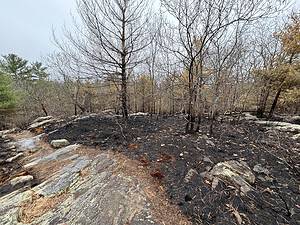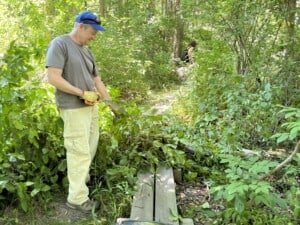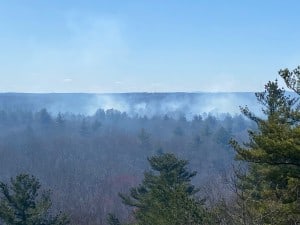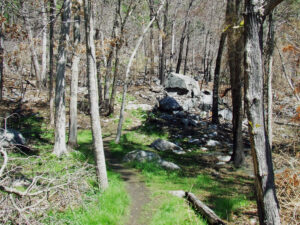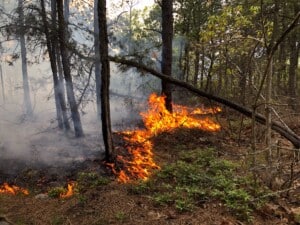Winter hiking can be intimidating. When temperatures get colder, days get shorter, and the snow falls, it can be hard to get motivated to get hiking and visit nature. One way to reduce this stress is to make sure that you are prepared and equipped for the elements. The Blue Hills offers many unique winter experiences and views, don’t let winter keep you inside for months! Read about our tips for not only surviving, but also thriving during the winter!
Make a plan, bring a map, and let someone know where you are. These are tips that apply year, but especially in the winter months when freezing could be a concern. Before heading out to hike in unfamiliar territory, always have a plan and bring a map. Many hiking trails have maps available online that we recommend you download to your phone or mobile device or print a paper copy and place it in a waterproof sealed bag while hiking. Don’t rely on cell service to try to find a map when it may be too late to prevent you from getting lost. It’s also a good practice to let family and friends know where you are hiking and what time to expect you back. If you get lost and need help, your safety net of family and friends can alert local authorities and search and rescue. Need an idea for a plan? Check out our free trail chart!
Dress in non-cotton layers. When deciding how to dress in the winter months for a hike, find inspiration in layers like an onion! By dressing in layers, you have more opportunity to insulate air and use your own body temperature to stay warm by keeping that warm air close to your body. If you get too cold or too warm, you can always add or remove a layer for comfort. You don’t want to be sweating, but you do want to be comfortable. Sweat can get extra cold when exposed to cold air, so try to regulate your body temperature to be comfortable without freezing or sweating by playing around with layers. Be sure to have a hat and gloves, too! We recommend sweat wicking materials and wool and to avoid cotton, as cotton will stay wet and can freeze you.
Wear proper footwear. Afraid of getting cold feet? Try getting some thick, wool socks and insulated hiking boots. With snow and ice on the ground (and sometimes snow falling around us), it’s important to keep your toes and feet warm and dry. Frostbite is mostly likely to occur in extremities (like the fingers, toes, nose, etc.) so making sure that these areas are warm and that blood is circulating is very important in the winter. It might be a good idea to bring a spare pair of socks in case your get wet!
Start early, bring a light. In the winter, and especially in New England, the sun will set very early in the day. Don’t get caught in the dark—start your hike early and plan for darkness by bringing a flashlight or headlamp with extra batteries. Remember, in the woods it gets darker even earlier because of tree coverage so plan accordingly.
Prepare for the elements, have the right gear. Have you tried climbing a big hill that is covered in snow and ice? What about going down the same big hill? It’s not easy with just a regular sneaker or hiking boot. Sometimes ice and snow require extra equipment to safely and comfortably traverse. We recommend a pair of microspikes. Microspikes are metal claws that slip over your shoe or boot and give you extra traction in the snow. There are many brands to choose from and they can be purchased at many locations, including REI and EMS.
If there is a heavy snowfall and the snow is not yet packed down, then it’s perfect conditions to try snowshoeing. Snowshoes might look large and cumbersome, but when the conditions are right, they are actually very easy to use and make walking across the snow much easier and more enjoyable. Snowshoes come in many different brands and styles, but generally, they all help accomplish the same goal. You can easily carry snowshoes by strapping them to the outside of your backpack with a bungee cord or any tie that is already part of your pack.

Photo by Kim Kroha
If the weather dips below freezing, carrying water in a hydration vest or an external bottle might freeze. Consider making sure your water is in a backpack or insulated in some way to protect it from the cold. The best bet is to make sure your water is near your body, resting close to your back inside your pack.
Be ready to turn around if necessary. Winter conditions can change quickly. This might mean that the predicted snow and wind comes 1 or 2 hours earlier than the weather app or meteorologist on TV said it would. Safety should always be the priority when adventuring in the outdoors, and this is even more important in the winter. Being stuck in a snow and wind storm can make for “whiteout” conditions, where visibility is low. If you sense the weather taking a turn, you should consider taking a turn as well— a turnaround and get out before you get lost. Don’t get caught with “summit fever”, remember that the further into the trail you travel, the further from your car you are.

Joe Simeone from Stoughton
We hope that the winter and snow does not deter you from enjoying the Blue Hills! Being prepared is the best way to ensure that the experience is safe and enjoyable. The winter season offers many beautiful sights and experiences that other seasons can’t provide– the snow on the trees, the quiet from fewer hikers and the snow dulling the sounds, and the frozen bodies of water are all unique to winter.


